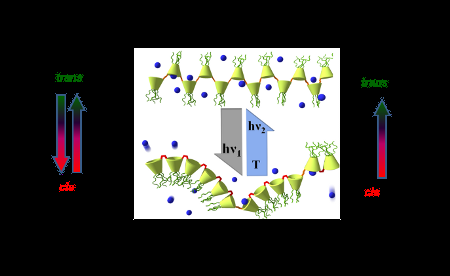Drawing and writing in liquid with light (w/ Video)

University of Helsinki researchers have manufactured photochemically active polymers which can be dissolved in water or certain alcohols. The new soluble, photosensitive polymer was created by doctoral student Szymon Wiktorowicz.
In the study, a 365-nm laser was aimed at a solution into which the polymer was partially dissolved. When exposed to light, the polymer switched to its cis conformation, dissolving completely and leaving a clear form which was visible in the cloudy solution.
The polymer chain created by Wiktorowicz includes azo compounds which can be switched from a trans conformation to a cis conformation using light. As the two conformations are different in solubility, a ray of light can "draw" in an ethanol-based dispersion of the polymer. The switch from trans to cis happens in the entire polymer chain.
This effect where light causes the polymer to dissolve completely and be made visible can last several hours depending, for example, on the concentration of the solution.
Light-sensitive polymers are nothing new to chemists. Light has been used for drawing on a solid surface, such as a TV screen or an LCD monitor, but drawing in liquid has so far been impossible.
This discovery is particularly significant for the development of new materials for optics and electronics.
More information: Macromolecules 2013, 46 (15), pp. 6209, Using Light To Tune Thermo-Responsive Behavior and Host–Guest Interactions in Tegylated Poly(azocalix[4]arene)s, DOI: 10.1021/ma4011457
Provided by University of Helsinki



















